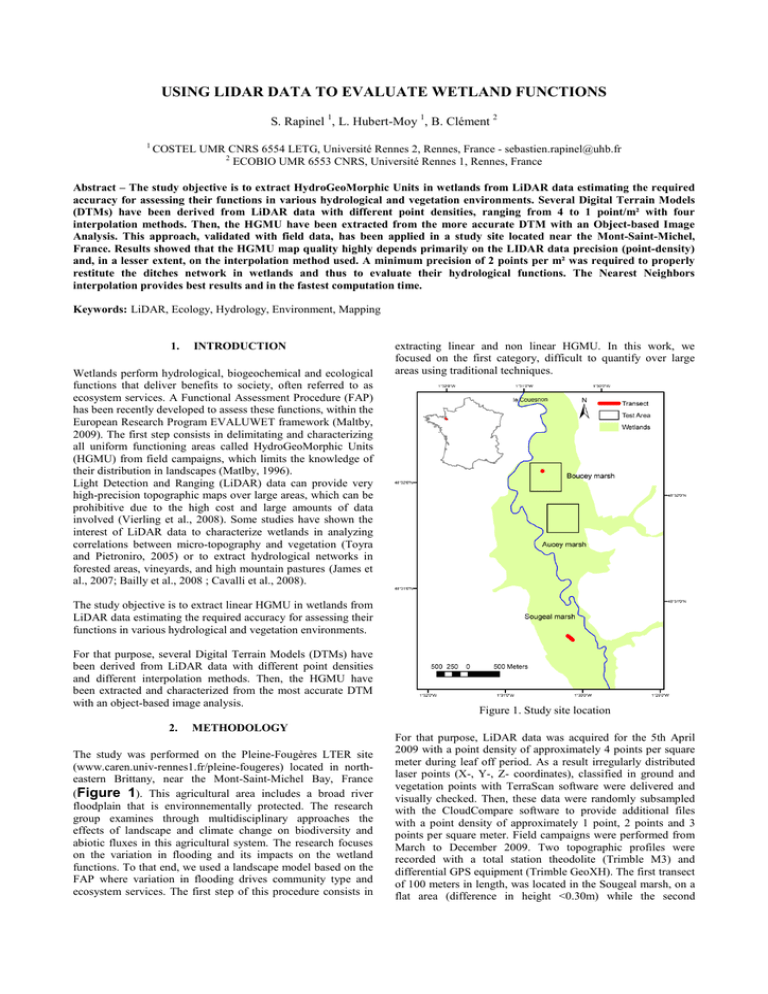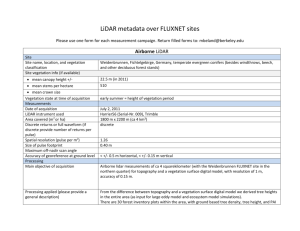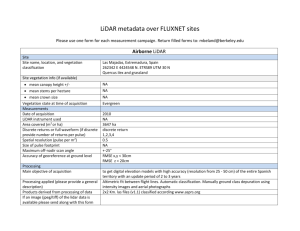USING LIDAR DATA TO EVALUATE WETLAND FUNCTIONS S. Rapinel , L. Hubert-Moy
advertisement

USING LIDAR DATA TO EVALUATE WETLAND FUNCTIONS S. Rapinel 1, L. Hubert-Moy 1, B. Clément 2 1 COSTEL UMR CNRS 6554 LETG, Université Rennes 2, Rennes, France - sebastien.rapinel@uhb.fr 2 ECOBIO UMR 6553 CNRS, Université Rennes 1, Rennes, France Abstract – The study objective is to extract HydroGeoMorphic Units in wetlands from LiDAR data estimating the required accuracy for assessing their functions in various hydrological and vegetation environments. Several Digital Terrain Models (DTMs) have been derived from LiDAR data with different point densities, ranging from 4 to 1 point/m² with four interpolation methods. Then, the HGMU have been extracted from the more accurate DTM with an Object-based Image Analysis. This approach, validated with field data, has been applied in a study site located near the Mont-Saint-Michel, France. Results showed that the HGMU map quality highly depends primarily on the LIDAR data precision (point-density) and, in a lesser extent, on the interpolation method used. A minimum precision of 2 points per m² was required to properly restitute the ditches network in wetlands and thus to evaluate their hydrological functions. The Nearest Neighbors interpolation provides best results and in the fastest computation time. Keywords: LiDAR, Ecology, Hydrology, Environment, Mapping 1. INTRODUCTION Wetlands perform hydrological, biogeochemical and ecological functions that deliver benefits to society, often referred to as ecosystem services. A Functional Assessment Procedure (FAP) has been recently developed to assess these functions, within the European Research Program EVALUWET framework (Maltby, 2009). The first step consists in delimitating and characterizing all uniform functioning areas called HydroGeoMorphic Units (HGMU) from field campaigns, which limits the knowledge of their distribution in landscapes (Matlby, 1996). Light Detection and Ranging (LiDAR) data can provide very high-precision topographic maps over large areas, which can be prohibitive due to the high cost and large amounts of data involved (Vierling et al., 2008). Some studies have shown the interest of LiDAR data to characterize wetlands in analyzing correlations between micro-topography and vegetation (Toyra and Pietroniro, 2005) or to extract hydrological networks in forested areas, vineyards, and high mountain pastures (James et al., 2007; Bailly et al., 2008 ; Cavalli et al., 2008). extracting linear and non linear HGMU. In this work, we focused on the first category, difficult to quantify over large areas using traditional techniques. The study objective is to extract linear HGMU in wetlands from LiDAR data estimating the required accuracy for assessing their functions in various hydrological and vegetation environments. For that purpose, several Digital Terrain Models (DTMs) have been derived from LiDAR data with different point densities and different interpolation methods. Then, the HGMU have been extracted and characterized from the most accurate DTM with an object-based image analysis. 2. Figure 1. Study site location METHODOLOGY The study was performed on the Pleine-Fougères LTER site (www.caren.univ-rennes1.fr/pleine-fougeres) located in northeastern Brittany, near the Mont-Saint-Michel Bay, France (Figure 1). This agricultural area includes a broad river floodplain that is environnementally protected. The research group examines through multidisciplinary approaches the effects of landscape and climate change on biodiversity and abiotic fluxes in this agricultural system. The research focuses on the variation in flooding and its impacts on the wetland functions. To that end, we used a landscape model based on the FAP where variation in flooding drives community type and ecosystem services. The first step of this procedure consists in For that purpose, LiDAR data was acquired for the 5th April 2009 with a point density of approximately 4 points per square meter during leaf off period. As a result irregularly distributed laser points (X-, Y-, Z- coordinates), classified in ground and vegetation points with TerraScan software were delivered and visually checked. Then, these data were randomly subsampled with the CloudCompare software to provide additional files with a point density of approximately 1 point, 2 points and 3 points per square meter. Field campaigns were performed from March to December 2009. Two topographic profiles were recorded with a total station theodolite (Trimble M3) and differential GPS equipment (Trimble GeoXH). The first transect of 100 meters in length, was located in the Sougeal marsh, on a flat area (difference in height <0.30m) while the second transect, located in the Boucey marsh, covers a ditch section of 4 meters length with a deeper slope (difference in height >0.50m). All field measurements were integrated into a GIS database. The irregularly dispersed laser points assumed to correspond to the ground were used to derive high–accuracy Digital Terrain Models (DTMs) with four interpolation methods, Nearest Neighbors (NN), Inverse Distance Weighted (IDW), Spline and ordinary kriging. The set of parameters used for these calculations is shown in Table A. For the kriging method, a variogram was calculated for each test area. The output grid cell datasets were fixed at 0.50 meter. Calculations were run for the four point densities. Mean elevation differences between the field-measurements and the LiDAR DTMs were measured by the Root Mean Square Error (RMSE). Table A. Interpolations parameters Interpolation NN IDW Spline Kriging Parameters None Power=2 ; Search radius=variable with 12 points Type=tension ; Weight = 0.1 ; Number of points=12 Sougeal marsh: Variogram type = Power Power 1.27 , Length 150, Slope 0.005, Nugget effect 0.01 Boucey marsh: Variogram type = Exponential Scale 0.02 ,Length 30, Nugget effect 0.012 Then, linear HGMU were extracted from the DTM with the lowest RMSE by an object-oriented approach performed with an eCognition software package: A line extraction algorithm was applied on DTM to detect linear objects. Then, primitive objects were segmented and merged along their main direction. Finally, linear objects were classified in four classes according to their depth (Table B). This approach was applied on two close areas (Test areas) of 25 hectares each within the study site to evaluate the impact of wooded vegetation on DTM’ accuracy: in the first one, located in the Boucey marsh, ditches are often bordered by tree-lines, while there are no wooded hedges in the Aucey marsh. Classification results were validated with a HGMU field map. 3. RESULTS AND DISCUSSION RMSE values of the DTMs calculated for the two transects were compared for the four interpolation methods and the four ground-point densities (Table C). On the Sougeal marsh, all DTMs have the same global RMSE value (0.12 m), whatever the ground-point density or the interpolation method. On flat herbaceous meadows, RMSE values decrease by less than 0.05 m. On the contrary, on flooded areas, where no LiDAR returns occur because of the presence of open water, RMSE values increase up to 0.30 m. On the flow ditch located at the Boucey marsh, RSME values range from 0.12 to 0.27 m. As expected, best results were obtained with a higher ground-point density. RSME values significantly increase with a ground point density of 1 point per m². DTMs derived using the Nearest Neighbors or the Spline interpolation methods (RMSE: 0.12 m) have a better accuracy than DTMs derived using the Inverse Distance Weighted (RMSE: 0.15 m) and the kriging methods (RMSE: 0.19 m). These results confirm a previous study showing the superiority of the NN interpolation method compared to the IDW for DTMs derived from high point density datasets (Bater and Coops, 2009). The comparison between the DTMs profiles derived from LiDAR data and the field measurements shows that all DTMs underestimate the ditch depth ( Figure 2). This could be explained by the presence of open water and dense herbaceous vegetation within the ditch. Figure 2 also highlighted the fact that the DTMs obtained by the NN interpolation method with a ground-point density of 4 points per m² best fitted with field measurements. This DTM was therefore selected for the detection of linear HGMU. Table C. RMSE values according to the ground-point density and the interpolation method (in meters) Interpo lation method NN IDW Spline Kriging Ground-point density (m²) Boucey marsh Sougeal marsh 4 3 2 1 4 3 2 1 0,14 0,12 0,16 0,24 0,12 0,12 0,12 0,12 0,15 0,15 0,14 0,27 0,12 0,12 0,12 0,12 0,14 0,15 0,16 0,24 0,12 0,12 0,12 0,12 0.19 0.20 0.18 0.27 0,12 0,12 0,12 0,12 Table B. Classification scheme of linear HGMU Linear HGMU classes 1. Drainage ditch 2. Flow ditch 3. Evacuation ditch 4. Channel Characteristic Depth <20 cm No variation between ditch’s and adjoining parcel’s vegetation Depth <50 cm Variation between ditch’s and adjoining parcel’s vegetation Depth >50 cm Large variation between ditch’s and adjoining parcel’s vegetation Depth >50 cm ; wide > 100 cm Large variation between ditch’s and adjoining parcel’s vegetation Figure 2. Comparison between DTMs derived from LiDAR data and field measurements on a ditch The results of the classification performed with the objectoriented approach to extract linear HGM showed significant accuracy differences between classes (Table D). Channels and evacuation ditches were better identified than drainage and flow ditches, because the latter are less deep and wider. On the marsh Boucey, accuracy levels were lower because of the presence of hedgerows along the ditches that leads to no LiDAR returns. This finding is particularly true for drainage ditches, less deep and with a higher proportion of area covered by tree canopy. The results also pointed out that all classes were detected with a very small over detection. Linear HGMU maps are presented on Figure 3. Almost all linear HGMU that were not detected by the object-oriented approach will be successfully mapped by photo-interpretation techniques. Table D. Accuracy indicators of the linear HGMU classification on Aucey and Boucey marshes fastest computation time, global computing time being less than 10 minutes for a 25-hectares area including DTM generation and automatic linear HGMU extraction. Moreover, two limitant factors have been identified for the mapping of linear HGMU: the presence of open water and vegetation, even during the leave-off period. From these results, the mapping of HGMU is currently carried out on a 650 km² watershed in the Dordogne region with over 8 billions of LiDAR points in order to evaluate wetland hydrological functions. REFERENCES Detection (%) Drainage ditch Flow ditch Evacuation ditch Channel Aucey marsh Well Over detected detected Boucey marsh Well Over detected detected 56.8 00.9 32.2 03.0 36.9 04.5 58.9 01.6 93.2 00.0 82.2 05.7 95.4 00.0 J. S. Bailly, P. Lagacherie, C. Millier, C. Puech, et P. Kosuth, “Agrarian landscapes linear features detection from LiDAR: application to artificial drainage networks,” International Journal of Remote Sensing, vol. 29, n°. 11, p. 3489-350, 2008. W. Bater and N. C. Coops, “Evaluating error associated with lidar-derived DEM interpolation,” Computers & Geosciences, vol. 35, n°. 2, p. 289-300, 2009. M. Cavalli, P. Tarolli, L. Marchi and G. Dalla Fontana, “The effectiveness of airborne LiDAR data in the recognition of channel-bed morphology,” CATENA, vol. 73, n°. 3, p. 249-260, 2008. L. A. James, D. G. Watson, and W. F. Hansen, “Using LiDAR data to map gullies and headwater streams under forest canopy: South Carolina, USA,” CATENA, vol. 71, n°. 1, p. 132-144, 2007. E. Maltby, N. Mockler, and R. Mcinnes, “Denitrification rates in river marginal wetlands and buffer zone management,” in Les colloques, vol. 79, p. 293-303, 1996. E. Maltby, Éd., “Functional Assessment of Wetlands: Towards Evaluation of Ecosystem Services”, Woodhead Publishing. Cambridge, 2009. Figure 3. Mapping of linear HGMU in Aucey (a) and Boucey (b) marshes 4. CONCLUSION In conclusion, results obtained in this study showed that the HGMU map quality highly depends primarily on the LIDAR data precision (point-density) and, in a lesser extent, on the interpolation method used. Based on our experiments, we found that differences between LIDAR DTMs and field measurements varied from 0.12 to 0.27 meters according to the LiDAR point density and the interpolation method. A minimum precision of 2 points per m² was required to properly restitute the ditches network in wetlands and thus to evaluate their hydrological functions. The Nearest Neighbors interpolation provides best results and in the J. Toyra and A. Pietroniro, “Towards operational monitoring of a northern wetland using geomatics-based techniques,” Remote Sensing of Environment, vol. 97, n°. 2, p. 174-191, 2005. K. T. Vierling, L. A. Vierling, W. A. Gould, S. Martinuzzi, and R. M. Clawges, “Lidar: shedding new light on habitat characterization and modeling,” Frontiers in Ecology and the Environment, vol. 6, n°. 2, p. 90-98, 2008. ACKNOWLEDGMENTS The authors acknowledge Elven Lanoé (INRA) and Jean Nabucet (COSTEL) for field support. The authors also thank Dr Olivier Dauteuil (Geosciences) for processing GPS data.




